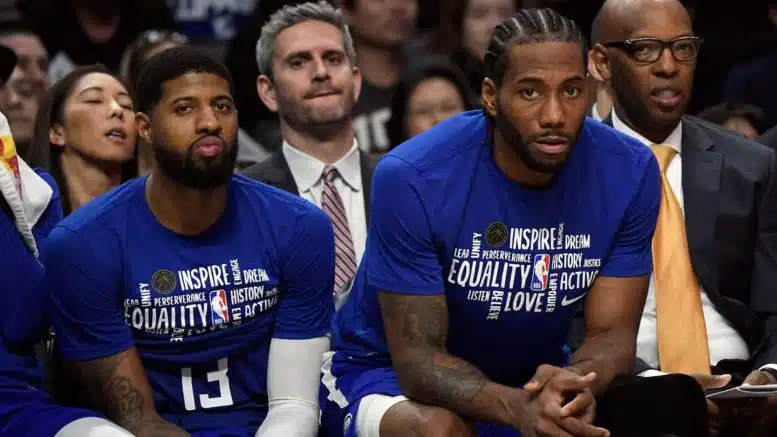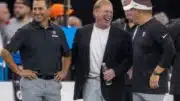In case the NBA has not made itself clear over the last few months, the league office is fed up with load management. There are 82 games on the schedule, and players are expected to play in every single game unless they are actually injured. The NBA is going so far now as to claim it has data that the dreaded phrase “load management” is no longer supported by science.
“We’ve gotten more data, and it just doesn’t show that resting, sitting guys out correlates with lack of injuries, or fatigue, or anything like that,” ex-Detroit Piston and current NBA EVP and head of basketball operations Joe Dumars said during a conference call with the National NBA media on Wednesday. “What it does show is maybe guys aren’t as efficient on the second night of a back-to-back.”
There has never been a world-renowned study published that has concluded NBA players will have a better chance of avoiding injury and elongating their careers with in-season rest. However, The Athletic’s Joe Vardon did point out that the NBA’s current fight against load management is contrary to comments made by Adam Silver during All-Star Weekend. Silver said then “There is real medical data and scientific data about what’s appropriate.”
What the medical profession has been saying publicly for years is that NBA players, as well as other athletes, are playing too much of one sport too early in life. Young people are entering the league with their potential money-making body parts already worn down.
ESPN’s Baxter Holmes reported in 2019 about the wear and tear that the AAU schedule puts on the bodies of young basketball players. He spoke to doctors who performed reconstructive ACL surgeries on nine-year-olds and even used Kobe Bryant as an example. Prior to Bryant’s tragic 2020 death, he was heavily involved in AAU coaching and he acknowledged that the schedule was far more rigorous than the “five tournaments a year,” in which he played in high school.
Last season, LeBron James told Marc Stein that he was limiting the number of AAU tournaments in which his sons would participate. The Washington Post’s Ian McMahan reported in August about how sports specialization at an early age increases injury risk. He spoke to a Boston children’s doctor who recommended that the number of hours that young athletes train should not exceed the number of their age (i.e. 12 hours a week for a 12-year-old.)
The NBA has long been aware of the problem of its future athletes being overtrained at a young age. Per Holmes, the NBA and USA Basketball first put out a list of recommendations for the training of young players in 2016. NBA doctors are well aware of the stress that has been put on the bodies of the players long before they get to the draft combine.
Unfortunately for the NBA, it can beg and plead with teen and pre-teen players, parents, and coaches to rest the kids but the words don’t speak as loud as those dollar signs. College is expensive and Dillon Brooks just inked an $80 million deal after being summarily dismissed by the team that drafted him. Kids are going to push themselves, and be pushed by the adults, because of the potential future money, along with the money they can generate for AAU programs in the present.
When these kids with bad knees and feet enter the league at 19 years old, the teams have to do the best that they can to shepherd these Goliath talents with the frames of David. Only 50 or so players even qualify under the league’s “Player Participation Policy,” but those are the players whose health matters the most.
Zion Willamson is one of the biggest draws in the NBA. LeBron James and Stephen Curry’s stardom would be a lock for his future, except that of his four seasons in the league he has been healthy for only one.
The stars carry the NBA like no other sport, because they have the most individual impact and play in the most intimate setting of all the major sports. It makes sense that the league wants them on the floor as much as possible, but this new push for 82 games to be the goal for players may be short-sighted.
That has been the regular-season schedule since the 1967-68 season, but back then there were 12 teams and three playoff rounds. When Magic Johnson won his first championship as a rookie there were 22 teams and although there was a fourth playoff series, the first round was a best of three.
In 2023, there are 30 NBA teams, and a best-of-two play-in tournament that leads into four best-of-seven playoff rounds. Also, teams have more than one sharpshooter, a la Reggie Miller, on the floor these days for players to chase around screens. The game is more frantic, covers more space, and is played by people who have played far more basketball at 19 years old than the college seniors who entered the NBA in the 20th century.
I am all for teams making an earnest effort to schedule player rest around the national television schedule. Those are the crown jewel contests until the postseason begins. All of these other new rules about avoiding sitting players on the road and the league gaining access to team medical records to be the judge of injury severity, is the NBA risking cutting its nose to spite its face.
The 2022-23 NBA season was a rousing success. Playoff ratings records were reached, and regular-season viewership has largely remained steady since the turn of the millennium. There is plenty for the league to work on to improve the product — my two cents is the number of jerseys has gotten out of hand.
The league interfering with the maintenance plans that teams have for their star players, though, has the chance of exacerbating a problem that it has no answer for. The NBA game and the road to it are more rigorous than it has ever been, and there are no signs of that changing.
Original source here
#Emphasis #82game #schedule #wont #solve #NBAs #biggest #problem





